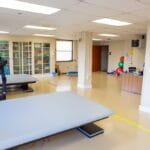By Elizabeth Pagel-Hogan
Cedarville University, a small Christian-centered university in Cedarville, Ohio, is preparing for big growth and changes in the healthcare terrain. Cedarville graduates across healthcare fields will be ready for collaborative healthcare and focused on better patient outcomes. A physical sign of this emerging trend is the new nursing building on campus housing both the pharmacy and nursing programs.
“It was intentionally built it so we could have interdepartmental collaboration with high tech simulation,” said Jan Conway, Dean of Cedarville University School of Nursing and Senior Professor. “There are labs to see patients at some point, but right now students are learning to work together in the delivery of care. A big focus in healthcare today in interdisciplinary care.”
Conway has seen many changes in her 34 years at Cedarville. What she sees on the horizon, influenced by the Affordable Healthcare Act and reinforced by national studies, is a new focus on collaborative patient care.
“It’s a national agenda with a major focus on collaborative practice rather than ‘I’m the leader of the health team.’ The goal is quality patient outcomes and cost effectiveness.” said Conway. “A wholisitc approach is cost effective, offers better resources for patient, helps patients understand their plan of care. Nurses, social workers, allied health professionals are coming together to say ‘what piece can we contribute?’ We’re starting this approach with our new facility and in the high-tech simulation labs where students can work collaborative and contribute in their different roles.”
Marc Sweeney, Dean of Cedarville University School of Pharmacy, feels the environment at Cedarville is unique when it comes to this new approach and preparing students to for professional careers grounded in collaboration.
“The attitude of collaboration, plus the technology and resources, it’s very unique having it all at the same place,” says Sweeney. “When Cedarville built the nursing building and added the Master of Nursing and Doctor of Pharmacy programs they were built with collaboration in mind.”
Evan Hellwig was a student at Cedarville and is now Chair of the Department of Kinesiology and Allied Health. Hellwig’s excitement is contagious when he discusses the advantages for students enrolled in the athletic training program at Cedarville.
“The athletic training students have access to the simulation lab in the nursing department. The new technology available there includes a mannequin that you can program with a variety of scenarios. The students can act as clinicians while the mannequin responds,” Hellwig says. “The nursing department has worked wonderfully with our clinical educators to develop these scenarios. So now when our athletic training students are in their clinical rotations they have already experienced how to assess. Some literally crash and burn in a safe way in the lab. They feel so much more confident and prepared. ”
Hellwig echoes Sweeney’s assessment that Cedarville offers unique experiences for students pursuing healthcare careers. He estimates that out of 350 accredited athletic training program Cedarville students are in a select group of only a handful of athletic training programs that can give students access to this kind of technology.
Cedarville University, in northwest Ohio, just announced it’s tenth president, Thomas White, Ph.D. Cedarville started as a liberal arts school but now offers the full gamut of programs many Christina colleges or universities do not. Currently Cedarville enrolls 3400 undergraduate students, but the university has a vision to enroll 10,000 students, 4000 undergraduates and 6000 online, adult and graduate students, by the year 2020.
“We are Christ-centered learning community and Biblically based. There’s a strong emphasis that permeates the campus, from students to faculty,” explains Mark Weinstein, Executive Director of Public Relations.
“We’re not a huge campus, but when you have a smaller group the opportunities for collaboration are much greater than when you have huge institutions. That’s something unique to Cedarville, we’re at the table talking and discussing integrating at the faculty and student level,” says Sweeney.
Conway described a example of this integration.
“This past year one of the pharmacy faculty and nursing faculty were teaching basic level research courses together. They planned classes together and taught classes together in a team approach, in the end the students had a research presentation and had to present the rationale from a nursing approach and a pharmacy approach. Students are recognizing each other and the need to work together,” said Conway.
Cedarville students aren’t stuck in labs all day. Melissa McNicol, a graduate student in the Doctor of Pharmacy program, is working in a retail pharmacy.
“We are given the opportunity to experience all types of pharmacy practice before we graduate, “ says McNicol. “We have already completed two rotations through retail pharmacies, both chain and independent. Next year we will do two rotations in hospitals, and then our last year of school will be all rotations. This will allow us to be able to have experiences in all types of pharmacy practice and determine which area is the best fit for us.”
Students also get experiences at community health fairs and service learning projects. Here they get hands-on experience with interdisciplinary care.
“When we participate in community screening events, health fairs, it’s interdisciplinary students and faculty doing this. They are just students taking care of patients, not looking at their disciplines,” explained Sweeney.
“Also in nursing we are sharing with other disciplines some service learning projects where students work with outside agency or client project to work on problem, these kinds of projects can be handled in interdisciplinary ways,” said Conway. “Last year at an industrial business, students worked with the vendors for the snack machines and identified healthy foods. They got the vendor to bring in healthy foods for the workers. It is unheard of in years past to have students have an influence in care. A year ago they worked on blood pressure screening, this year it was nutrition. They are supporting the nurse at the facility, asking what are the problems, how can we help you?” said Conway.
For more information, visit www.cedarville.edu.
Throughout the year, our writers feature fresh, in-depth, and relevant information for our audience of 40,000+ healthcare leaders and professionals. As a healthcare business publication, we cover and cherish our relationship with the entire health care industry including administrators, nurses, physicians, physical therapists, pharmacists, and more. We cover a broad spectrum from hospitals to medical offices to outpatient services to eye surgery centers to university settings. We focus on rehabilitation, nursing homes, home care, hospice as well as men’s health, women’s heath, and pediatrics.







